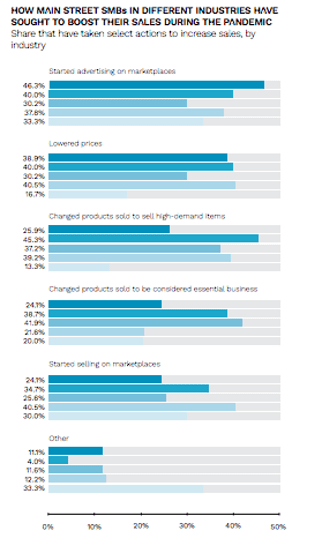SMBs Get Back To Media Markets Despite Cash Flow Concerns

As the “buy local” message has become an increasingly clear refrain among shoppers during the pandemic period, it has motivated the marketers for small and medium-sized businesses (SMBs) to buy more advertising, increase their social media activities and broaden their mix of channels.
According to data released this week by Borrell and Associates, SMBs spent much of Q1 gradually increasing their ad-buy efforts, with 35 percent reporting they’d signed an advertising contract and 47 percent indicating they had run ads with local media. Meanwhile, 60 percent reported they have maintained or increased their spending compared with last year.
The data also indicated that as the second quarter begins SMBs are looking to ramp up their social media ad spend, a finding that corresponds with PYMNTS’ most recent SMB survey data — which demonstrated that that interesting in more widely diversifying their digital media presence comes as part and parcel of the larger shift of business toward digital channels.
PYMNTS research on Main Street SMBs further found that outreach strategies for boosting sales vary depending on the type of products and services they sell.

Those in the services industry, including construction and retail trade businesses, are among the most likely to use digital platforms to promote their businesses — 46 percent reported they’ve started advertising on digital marketplaces and aggregators since the pandemic began, and 24 percent have begun selling products on digital marketplaces and aggregators in that time. The data also demonstrated that 38 percent of Main Street survivors in retail trade began advertising on digital marketplaces and aggregators while 41 percent began selling on digital marketplaces and aggregators during the past year.
The push, according to Borrell’s data, is also motivated along by belief that this is what the competition is doing, and thus what needs to be done for SMBs to stay competitive in the field as the national economy continues to attempt to recover.
And recovery, as the data out this week demonstrates, is very much a top-of-mind concern — and how it can be motivated to align more quickly. One-third of respondents say they will spend more this year than they did in 2019, 70 percent said they would include more types of media, 58 percent said they planned to increase the frequency of their messaging and 34 percent even expressed a willingness to move on to methods that will cost more.
A perhaps somewhat surprising answer from a third of SMB participants since, as PYMNTS data shows, cash flow remains a massive concern for SMBs nationwide even as vaccines proliferate and the pandemic period begins its end phase.
“You’d be surprised how much small businesses think about cash flow,” Victor Lang, co-founder and chief operating officer of Australia-based giniPredict told PYMNTS in an interview. “It’s not just about making sure you can keep the lights on,” Lang said. “When you understand your cash flow, you know how much you can invest to grow.”
The challenge for businesses, he said, is that in the world of business payments where sellers can wait 30, 60 or even 90 days for payments to come in, planning around when cash is coming in is very hard. Late B2B payments continue to add pressure on business cash flow, and entrepreneurs frequently have to rely on “gut feelings” about which invoices are likely to be paid late, Lang said.
That much uncertainty can make things like investing in marketing and ad buys extra challenging for firms looking to push more heavily into advertising, as those purchases are paid up front by merchants who still might be waiting for their funds to come in on the back end.
And yet, the data demonstrates, merchants are taking the risk and stepping up those marketing attempts across an increasing number of channels as nearly across the board they are united in the goal of driving up revenue among consumers they anticipate are returning soon to physical shopping.
Main Street SMBs continue to be more optimistic about how long the pandemic will continue to reduce their foot traffic, according to PYMNTS, and their outlook is growing rosier. The average Main Street Survivor as of March believed consumers will feel comfortable reengaging in the physical world by late October 2021 — just seven months from now.
The trouble is that consumers do not see themselves going back to stores until mid to late-February 2022. This leaves a roughly four-month gap between the time when Main Street survivors believe their foot traffic will recover and the time when their customers expect the pandemic’s impact on their lives to end. Which means some extra marketing might really just be in order now.
Because America’s SMBs clearly have some consumers who need some additional persuading to their optimistic outlook on things.
